Eye Muscle Surgery
Detecting Strabismus
Misalignment of the eyes, known as strabismus, is a common problem in childhood. Strabismus is recognized by noticing crossing or drifting out of one or both eyes. The drifting may be constant or intermittent. An examination by your pediatrician or eye doctor can confirm whether strabismus is present. The risk of strabismus is much higher when a family history of “lazy eye” or crossed eyes is present.

Before Surgery The Left Eye Is Drifting Out.

One Month After Eye Muscle Surgery, The Eyes Are Straight.
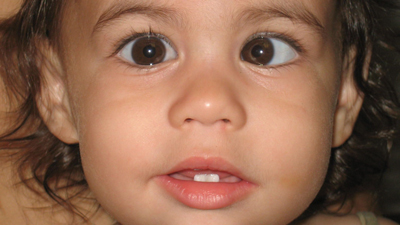
Before Surgery, The Left Eye Is Crossing Inward.
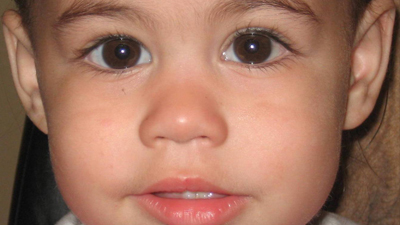
One Month After Eye Muscle Surgery, The Eyes Are Straight.
Children do not outgrow crossing
Many parents have been told that their child will outgrow crossing of the eyes, which is simply not true. It is normal for the eyes of infants up to four months of age to cross or drift out. However, after this time, eyes should be straight at all times. If you see drifting of the eyes after four months of age, bring this to the attention of your pediatrician or eye doctor.
What causes strabismus?
Six small eye muscles control the movement of each eye. The brain’s delicate control over these muscles allows the eyes to track together in all directions of gaze. Some children are born with an imbalance of this control, causing the eyes to cross or drift. Precise control of all six eye muscles is necessary for proper tracking and alignment of the eyes.
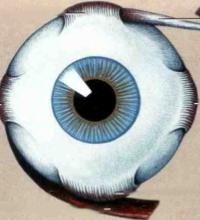
Six Muscles Of The Eye
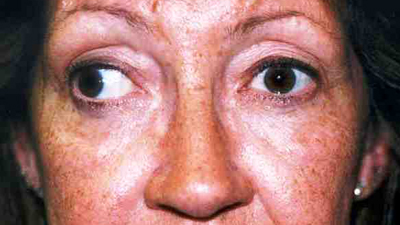
Before Surgery The Right Eye Is Drifting Out.
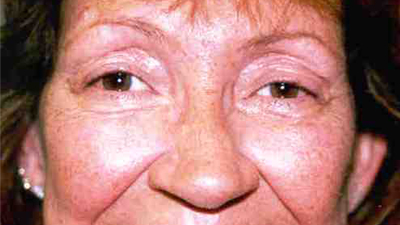
After Eye Muscle Surgery, The Eyes Are Straight.
Eye Muscle surgery
Eye muscle surgery is a simple outpatient procedure. The eye is not removed from the orbit, nor are any lasers used during the surgery. The procedure is done on an outpatient basis under general anesthesia and takes less than an hour to complete. After the patient is put to sleep, the thin clear tissue covering the eyeball is peeled back to give the surgeon access to the muscles that move the eye. Depending on the underlying problem, the muscles may be strengthened or weakened. For instance, in a patient with turning in of the eyes, the muscles that pull the eyes in are surgically weakened. Because the surgery is completed without ever entering the eyes, the risks involved are extremely small.
During surgery, the eye muscle is placed in a new position to restore the alignment of the eyes.

Pre-Op Muscle
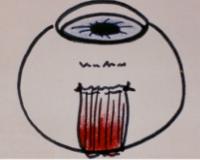
Post-Op Muscle
During surgery, the eye muscle is placed in a new position to restore the alignment of the eyes.
Commonly Asked Questions about Eye Muscle Surgery
How long does it take?
The surgery itself usually takes between thirty to sixty minutes to complete.
How do you know how much surgery to do?
The amount of surgery is based on the measurements of ocular misalignment done in the office.
Why is surgery often done on both eyes when only eye drifts?
When an eye drifts, it is usually not a problem with one eye versus the other. Rather, it is a problem with the balance between the eyes and the brain. In a patient with crossed eyes, when the right eye looks straight ahead, the left eye crosses in. When the left eye looks straight ahead, the right eye crosses in. Some patients favor one eye strongly, so only one eye seems to drift, when the problem is actually in both eyes. Based on the severity of misalignment, surgery may be recommended on one eye or both eyes.
What is the recovery time after surgery?
Children are usually back to school and adults back to work within a few days.
Do you take the eye out of the head and put it back during surgery?
No. The surgery is done with the lids held open, with the eye in its normal position.
Are there any scars after surgery?
The surgical incision is made through the thin tissue covering the white part of the eye. In most cases, the small scar is not noticeable. Incisions are never made through the skin.
What are the goals of surgery?
The primary goal is to restore straight eye alignment. In patients with double vision, the goal is to reduce the double vision as much as possible. Many patients also benefit from improved cosmetic appearance.
Is a patch worn after surgery?
Generally not. On occasion, a patch is used for the night after surgery.
Can eye muscle surgery be completed in adults?
Yes. Eye muscle surgery is safe in adults and children alike.
What is the chance of needing a second operation?
The likelihood of needing a second operation depends largely upon the problem for which the surgery is being done. Many eye muscle problems can be taken care of with one operation while others will likely need two or more surgeries.
What is the success rate of a second operation?
The success rate of the second surgery is usually as high as the first operation.
In a patient with drifting out of the eyes before surgery, is crossing and double vision normal after surgery?
Yes. In patients with drifting out of the eyes before surgery, it is normal for the eyes to cross inward and to experience double vision for a period of time after surgery. This immediate overcorrection is desirable since the eyes tend to progressively drift back outward after surgery. As the eyes progressively drift outward over the days to weeks after surgery, crossing and double vision almost always resolve.
Is recovery painful?
No. After surgery, the eyes feel “scratchy”, but not very painful.
This article was written by Dr. Scott Silverman, our fellowship-trained Pediatric Ophthalmologist.
Dr. Silverman is available at our locations in Sarasota and Lakewood Ranch, Florida. He specializes in children’s eye care, strabismus, amblyopia (lazy eye), and eye muscle surgery in children and adults.
Your Child's Vision

Amblyopia
What is Lazy Eye? Vision problems are common in children. Early recognition and treatment are the keys to preventing permanent visual impairment.



